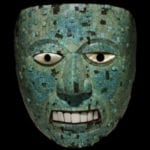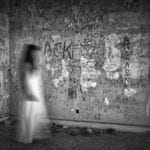Below, we have a list of 10 omens that people used to believe brought death. Strangely enough, in some cultures, these omens are still widely believed.
10Death Crowns
In the Appalachia, hardened crown-like masses of feathers found in pillows of ill people were viewed as an omen of death. These feather crowns measured 3–5 centimeters (2–3 in) in diameter and were about 1.5 centimeters (1 in) thick. They were known as “death crowns” or, less often, as “angel crowns.” The phenomenon of these death crowns seems to have been confined almost solely to Appalachia, due to the isolated nature of the area. However, the phenomenon also traveled to places like Missouri and Indiana or anywhere else where the mountain folk migrated. Death crowns were more than likely a consequence of an ill person’s movements (i.e., tossing and turning). If you found such an artifact inside an ill person’s pillow, it meant that the person would die within three days. It was said that one way to break the omen was to break the feather crown. However, if a death crown was found in the pillow of a recently deceased, it was viewed as a comforting sign, as it meant that the person went to heaven. Many of the still existing death crowns today have made their way into museums. Today, the largest collection of death crowns can be found in the Museum of Appalachia in Clinton, Tennessee.
9Black Butterflies
The meaning and symbolism of black butterflies changes from one culture to another, but they are usually seen as a sign of impending doom and death, especially in places such as Brazil, Colombia, Central America, and also China. Spotting a black butterfly in the house supposedly means that a member of that household would die, although on rare occasions black butterflies appear in the house after a family member has already died. According to the Celts, black butterflies are the souls of deceased people. When a deceased person fails to find their place in the afterlife, they turn into black butterflies and sometimes return to the places they used to live. Certain folklore also suggests that witches turn into black butterflies so that they could steal food without being recognized, although in Caribbean populations, spotting a black butterfly that is really a witch means that someone has cast an evil spell on you. In Mexico, the Black Witch moth is known as the “butterfly of death.” It is believed that when the butterfly of death enters a sick person’s house, that person will die. In southern Texas, however, it is believed that a death occurs only if the butterfly visits all four corners of the house. In Hawaii, a black butterfly is an embodiment of a loved one who has come to say goodbye.
8Halley’s Comet
In ancient cultures, people were baffled by comets since they were unlike other celestial bodies, which traveled across the skies at regular intervals. Instead, their appearance was erratic and unpredictable, and thus many people believed that comets were messages from the gods. Most cultures read the messages through interpretations of the images that they thought they saw upon looking at the comet. So, for example, many thought that the elongated form of the comet symbolized a fiery sword blazing across the night sky which meant war and death. Thus, it is not surprising that comets were blamed for various disasters. For example, the famous Bayeux tapestry portrays an attendant rushing to tell Harold about the celestial happening as he sits on his throne. Halley’s Comet appears at the upper left of the tapestry and supposedly expresses God’s wrath at Harold for breaking his oath to William and taking the throne. Shortly after, Harold was overthrown, and William took the throne. In Switzerland, Halley’s Comet was blamed for earthquakes, illnesses, red rain, and the birth of two-headed animals. In England, the Black Death was attributed to Halley’s Comet. Rumors even spread that Pope Calixtus III excommunicated Halley’s Comet as an instrument of the devil. This, of course, was not true, but the story persists to this day.
7Doppelgangers/Spirit Doubles
Doppelganger is a German word meaning a “double goer” and refers to a replica, apparition, or a double of a living person. However, the doppelganger phenomenon is not confined to Germany only. In Irish folklore, a doppelganger is better known as “Fetch,” and in Orkney Islands, people feared faeries called “Trows.” Trows were depicted as ugly, impish little creatures whose children were often sickly. Thus, they would often steal healthy human babies and replace them with their exact replicas. It was believed that these replicas eventually fell sick and died young. Thus, doppelgangers were often considered bad omens and sometimes even as signs of impending death. If the doppelganger was seen by the person’s relatives or friends, that meant that the person would fall ill or end up in a dangerous situation. However, if a person saw one’s own doppelganger, it could only mean that he would imminently die. It was said that doppelgangers, also known as “evil twins,” might try to provide misleading advice to the person they shadow as well as plant sinister ideas in their heads to cause confusion and uncertainty. As a result, people were often advised and discouraged from making conversation with their doppelgangers. The doppelganger became a popular symbol in horror literature. Fyodor Dostoyevsky, for example, explored the phenomenon in his book The Double, in which a poor clerk is driven to madness by poverty and lack of success in love. He then meets his own double, who is successful in everything he does. Finally, the double succeeds in disposing of the original clerk. However, there have been famous reports of the doppelganger phenomenon in real life, too. For example, it is said that Abraham Lincoln told his wife that he saw two faces (one much paler than the other) of himself in the mirror soon after he was elected president. His wife thought this meant that he would be elected to a second term but would not survive it. As it turned out, she was right.
6Deathwatch Beetle
Deathwatch beetles are pests that are known for damaging wooden furniture and the wooden structures of a building. During mating season, mature deathwatch beetles make tapping or ticking sounds by hitting their heads against the wood to attract mates. This sound is heard quite clearly on quiet nights in old houses. Over time, this sound became associated with sleepless nights that people spend beside a dying or dead person. As a result, the noise that deathwatch beetles make came to be interpreted as an omen of misfortune and death. The ticking sound of this wood-boring beetle goes by many names, the most notable one being “the death watch.” However, other names, depending on the area, exist and include: Clock of St. Paschal, St. John, St. Bernard, St. Anthony, St. Vital, or Madonna’s. It is said that the most appropriate name for this specific omen of death is the “clock of St. Pasquale” since Saint Pasquale supposedly had the ability to feel the imminence of death by touching a door (something he developed while pursuing his profession as a doorman at the convent).
5Solar Eclipse
In the past, solar eclipses were regarded as a mysterious disturbance in the natural order of the sky. It was seen as an indication that something was going wrong. In Vietnam, for example, it was widely believed that a giant frog was eating the Sun, while Viking cultures blamed wolves for gobbling down the Sun and causing a solar eclipse. In ancient China, the solar eclipse was blamed on a celestial dragon lunching on the Sun, and in ancient Greece, it was a sign of angry gods marking the beginning of disasters. Thus, it is not surprising that solar eclipses came to be known as omens of death, destruction, and disasters. Many tragic historical events, deaths in particular, were associated with solar eclipses. When Louis of Bavaria, who was the head of a great empire, witnessed a solar eclipse in AD 840, he was so terrified that he died shortly afterward. Another eclipse, which occurred in 1133, was visible both in Germany and England. In England, the eclipse was regarded as an omen of death for King Henry I. Shortly after, the king died in Normandy, and his death was seen as a confirmation of the omen. In Germany, the solar eclipse was associated with the sack of the city of Augsburg and the massacre of its inhabitants by Duke Frederick. Even today, in some parts of the world, solar eclipses are seen as an omen of death and disaster. In some cultures, it is believed that eclipses are dangerous to pregnant women and children. In many parts of India, people fast during a solar eclipse due to the belief that any food cooked during an eclipse is poisonous.
4Opals
Throughout history, some stones were prized and admired for their magical qualities, while others were denounced as vessels of evil. Opals were assigned to the latter category. It was widely believed that witches and sorcerers used opals to increase their magical powers, and it was said that they sometimes even focused them like laser beams on the people they wished to harm. Medieval Europeans tended to avoid opals because of their resemblance to the evil eye and their likeness to the eyes of cats, toads, and snakes. An opal that was utterly contaminated with evil was said to be capable of maiming or even killing the person wearing it. As the Black Death spread across the whole of Europe, a great number of people began blaming opals for the numerous deaths that occurred. It was noticed that opal-wearing victims of the Black Death had their opals turn brilliant, but just as quickly, that brilliance would soon disappear. In reality, the stone had altered because of the change from the warmth of the fever to the chill of death, but people believed that the stone had altered due to its evil influence on the victim’s fate. The stone was thus associated with the death of the victim, and wearing an opal soon became seen as an omen of death.
3Death Knocks
According to an old superstition, when three knocks are heard at the door and no one is there, it means that someone has died or is about to die. The three knocks are also sometimes known as the “three knocks of doom.” In Ireland, the three knocks of doom at the door and window both represent an omen of death. In Scotland, the knocks are perceived as a sign of death if they come at regular intervals of one to two minutes in duration. The three knocks superstition is also part of many Native American tribes. And of course, since spirits are not bound by physical restrictions, they can make noises in various ways, such as by thumping a stick on the ground (as opposed to knocking at the skin wall of a tepee, which could be quite a difficult feat). The three knocks of death can also be found in Jewish, Indian, and Arab traditions. In Africa, the “three knocks of doom” is an important aspect of the Yoruba religion of a god known as Orisha. A famous Yoruba tale called “The Oriate and His Brothers” describes a story of three brothers who came from the Oriate (“the high priest”) lineage. The brothers were also supposed to become Oriates through hard work and many rituals. However, the two older brothers had no patience and were jealous of their younger brother, who was patient and hard-working. Thus, they decided to throw the younger brother of a cliff. Unbeknownst to them, he survived. Shortly after, when the two brothers were practicing divination with seashells, they predicted death. At the same time, they heard three knocks on the door and saw the younger brother come in. Upon seeing him, the oldest brother died of a heart attack, and the other brother was killed by the village once the village folk learned of the two brothers’ devious plan.
2Phantom Funerals
Phantom funerals are mysterious processions foretelling the death of a loved one, with the ghostly procession taking the same route as the actual funeral will in the future. Sometimes, the witness of the phantom funeral can even recognize participants and see details that are later observed at the real funeral. However, it is said that if the person witnessing the phantom funeral peeks inside the casket, they will see their own dead body inside and thus death will inevitably follow. The phantom funeral phenomenon can be found in the folklore of the British Isles as well as in Germany and in Switzerland. Phantom funerals can only be seen by those with a special gift, although some churches are notorious as sites of phantom funerals. Phantom funerals are also known as “goblin” or “fairy” funerals because they are supposedly sent by faeries to unsettle humans. The mysterious procession of the phantom funeral can also sometimes be heard. In Welsh folklore, this is known as the “Tolaeth before the Burying.” The witness of the funeral can hear voices singing psalms, the regular tramp of the feet, and the sobbing and the groaning of the mourners. However, it is said that phantom funerals only touch one sense at a time, which means that when it is heard, it cannot be seen. Nevertheless, sometimes, when it has already been heard by the ear, it makes itself known to the eye also but in silence.
1Corpse Candles
Corpse candles are mysterious lights in the shape of white, blue, and yellow balls or candle flames that appear outside. These mysterious lights bop and float above the ground and are also known as ignis fatuus (foolish light), will-o’-the-wisp, and even the jack-o-lantern. They are especially common in marshy areas, and one possible explanation for the eerie light is that they are balls of glowing marsh gas. However, many far more sinister explanations exist, most of them explaining these lights as messengers of doom and death. It is believed that some corpse candles hover over the home of the person who is about to die. Other corpse candles hover halfway between the home of the person who is about to die and his ultimate grave site. Still others will supposedly hover over the chest of a sick person. Corpse candles also hover over the boats of fishermen who will soon drown. It is also believed that the corpse candle foretells the death of the person who sees it or of someone who is close to them. In Ireland, corpse candles are believed to lead phantom funerals. Laura Martisiute is a student from Ireland in love with books, writing, coffee, and cats.
























